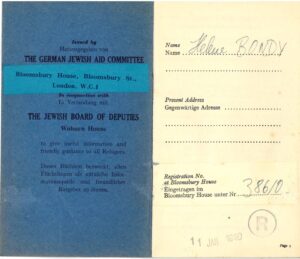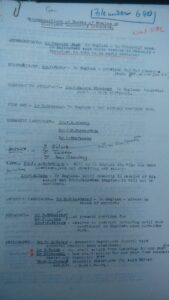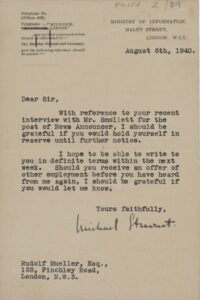To mark Refugee Week later this month (14-20 June), the IMLR is running a guided walk around Bloomsbury following the trail of the 1930s refugees from Nazi Europe. The walk brings to life work by the Research Centre for German & Austrian Exile Studies and uses voices and images from the IMLR’s exile archives to illustrate the stories uncovered by this research. This is the second of two blog posts by Miller Archivist Clare George on the Bloomsbury sites that played a role in this refugee community’s histories.
Few of the refugees from Nazi Germany had the means to support themselves in the UK and many relied on the myriad of voluntary organisations that sprang up to provide help with everything from welfare to visa applications and employment. As the offices of these bodies were concentrated in the district, Bloomsbury saw a daily influx of visitors arriving to register with them and seek assistance. Amongst the earliest was the Germany Emergency Committee, established by the Society of Friends in Euston Road in 1933, and the Jewish Refugees Committee, set up by Jewish community leaders at Woburn House in Tavistock Square in the same year. The Academic Assistance Council moved into Gordon Square in 1936 and was followed by the Church of England Committee for non-Aryan Christians in 1937. To the south of the district, in New Oxford Street, was Austrian Self Aid, one of the first groups set up by refugees themselves to help those still trying to leave Austria, and the Czech Refugee Trust Fund, the only organisation to receive government funding, had its offices in Mecklenburg Square. During the Second World War, an overarching committee coordinating these and other support organisations was formed and moved into 21 Bloomsbury Street, formerly the Palace Hotel. Bloomsbury House, as it was known to the refugees, provided office space for as many as 30 voluntary bodies and became the central registration point for all refugees from Nazi Germany.

‘While you are in England. Helpful information and guidance for every refugee’, issued to Helene Bondy by the German Jewish Aid Committee, Bloomsbury House, and the Jewish Board of Deputies, Woburn House, 1940 (Paul and Charlotte Bondy papers)

Recommendations of the Boards of Studies regarding displaced University Lecturers, Academic Assistance Council, University correspondence for the session 1933-1934 (UoL/CF/1/34/721)
The increasing presence of the University of London in Bloomsbury was another reason refugees were drawn to the district. The building of Senate House and the movement of the University’s administrative centre from Kensington to Bloomsbury in the 1930s had been driven by William Beveridge, Vice Chancellor of the University from 1926 to 1928. Beveridge was also behind the establishment of the Academic Assistance Council, a scheme supporting German Jewish academics dismissed from their posts following the passing of anti-Semitic legislation in Germany in April 1933. The University’s Boards of Studies liaised with the Council over displaced lecturers and by July 1935 had provided 55 temporary teaching or research posts to refugee academics, more than any other British university.
Educational institutions of various kinds were of course already long established in the neighbourhood, and the attendant student accommodation and clubs which spread across the district also played a role in the refugees’ history. Student Movement House, occupying the original Georgian building at 32 Russell Square until it was demolished in March 1939, was a social club run by the Student Christian Movement for international students. It included both Nazi and Jewish German students in the pre-war years, and the warden later recalled the poverty-stricken conditions in which refugee students lived in the backstreet slums of the district. Canterbury Hall in Cartwright Gardens was another a student facility with a historical connection to the refugees. A hall of residence until the start of the war, when the students were evacuated it was given over for the accommodation of members of the Czech Refugee Trust Fund in April 1940 and it became known to MI5 as a hotbed of Communist agitation.

Interview invitation from the Ministry of Information at Senate House to Austrian Jewish actor Martin Miller, 1940 (Miller/2/89)
In 1939 the newly built Senate House was emptied of most of the University’s administrative departments and filled instead with civil servants, journalists and others working for the Ministry of Information. Responsible for wartime publicity and propaganda, the Ministry of Information employed and commissioned artists, writers, journalists, researchers, and film directors. As a high proportion of refugees were from the creative industries and had journalistic and artistic skills and experience, and were also highly motivated to join the war against Hitler, many of them made an important contribution to the Ministry’s mission.
To find out more about this and other sites of historical importance to the refugees, please join us for a free guided tour led by Clare George (Miller Archivist/Research Centre for German & Austrian Exile Studies at the IMLR). Advanced booking is required. Please follow one of the following links to book:
17 June 2021, 11.00am – 12.30pm
19 June 2021, 11.00am – 12.30pm
Those who cannot make the guided walks, could instead listen to our audio walk, created for the Being Human Festival in November 2020.
Dr Clare George, Miller Archivist/Research Centre for German & Austrian Exile Studies at the IMLR
